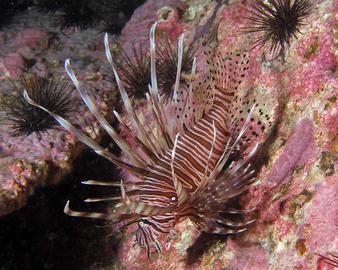If you haven't yet booked your space on one of our 2013 REEF Field Surveys, don't delay. They are filling up fast. A last minute opening is available on the Fiji trip aboard the Nai'a liveaboard, May 11-21 - we just had a cancellation, so if you want to join REEF Founder Paul Humann, REEF Director of Science Christy Semmens, and a boat full of enthusiastic South Pacific fishwatchers, get in touch with our travel agent at Caradonna right away - 1-877-295-REEF (7333) or REEF@caradonna.com.
REEF Director of Special Projects, Lad Akins, has co-authored several recent scientific publications on the invasive lionfish in the western Atlantic, including:
REEF members are at the heart of our grassroots marine conservation programs. Over 43,000 divers, snorkelers, students, and armchair naturalists stand behind our mission.
When University of Kansas graduate Keri Kenning joined REEF in August 2012 as a Marine Conservation Intern, Keys residents constantly reminded her, “You’re not in Kansas anymore.” Five months, sixty dives, and zero lionfish stings later, Keri has abstained from clicking those ruby red heels together and returning to Kansas. She is staying at REEF headquarters in Key Largo as the new Communications and Affiliate Program Manager. Keri graduated in May 2012 from the University of Kansas with a Bachelor of Arts in Biology and University Honors.
Advanced Assessment Team trip for annual monitoring of the Olympic Coast National Marine Sanctuary
Dreaming of diving? Want to talk fish? Share scuba stories? Be sure to visit REEF and get your underwater fill at the Our World Underwater consumer dive show in Chicago, February 15-17th. REEF staff and volunteers will be at Booth 1004, ready to tell you about our exciting programs, answer your questions, and equip you with the latest REEF gear. We will be offering free REEF memberships, so stop by and sign up as a REEF member if you haven't already.
Invasive lionfish in the western Atlantic are known to be voracious predators. Their unusual hunting behavior suggests that they could prey on most fish species within their gape size limits. Significant research by REEF researchers and others has been conducted looking at stomach contents of lionfish to identify prey. However, relatively few prey species have been identified because of the challenge of identifying partly digested prey. It is also difficult to know how well the identifiable diet reflects the unidentified portion.
This paper explores detectability rates of lionfish using underwater visual census methods such as belt transects and stationary visual census. Knowing the error in these methods specficially for lionfish is necessary to help study this invasive species in the western Atlantic.




